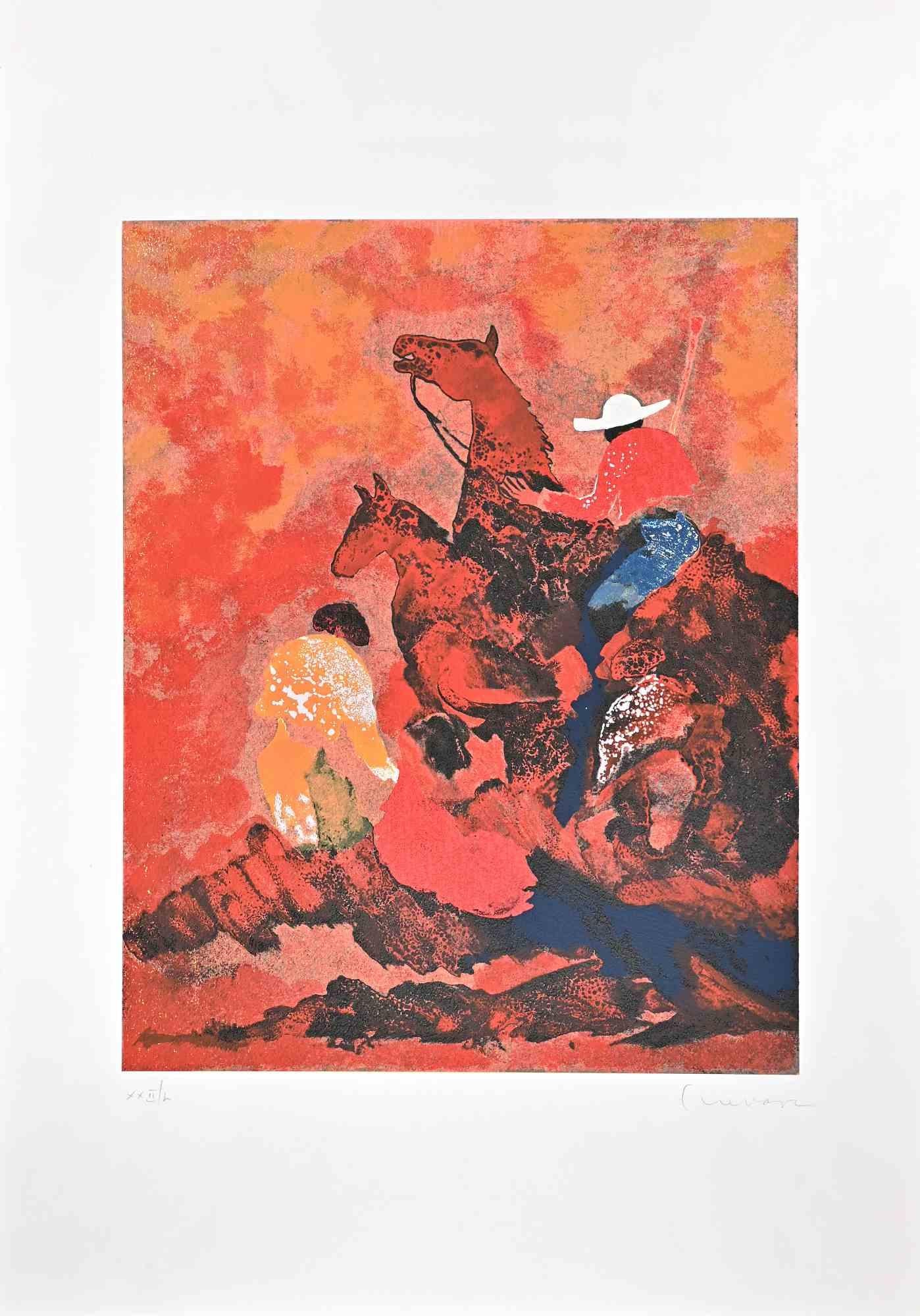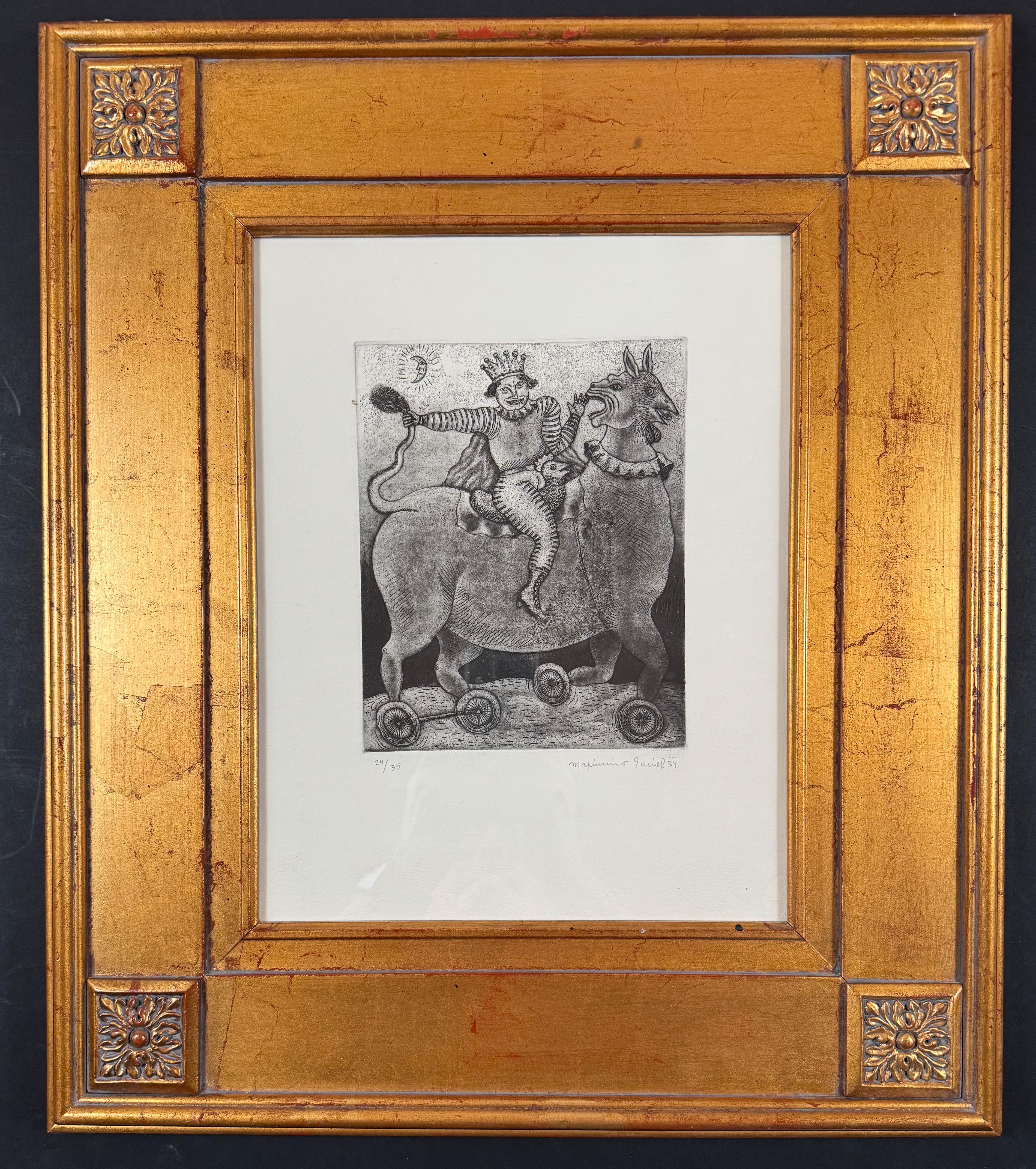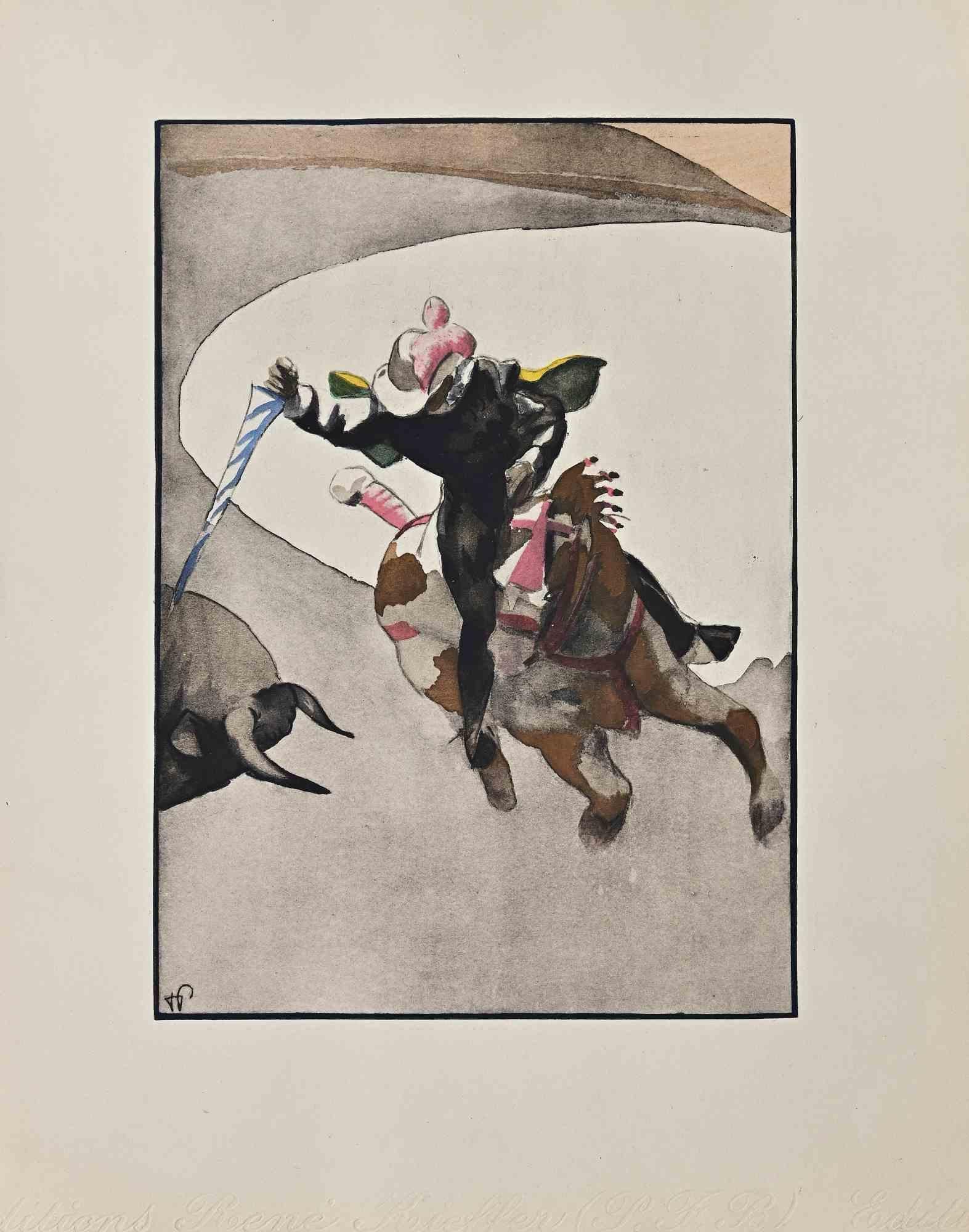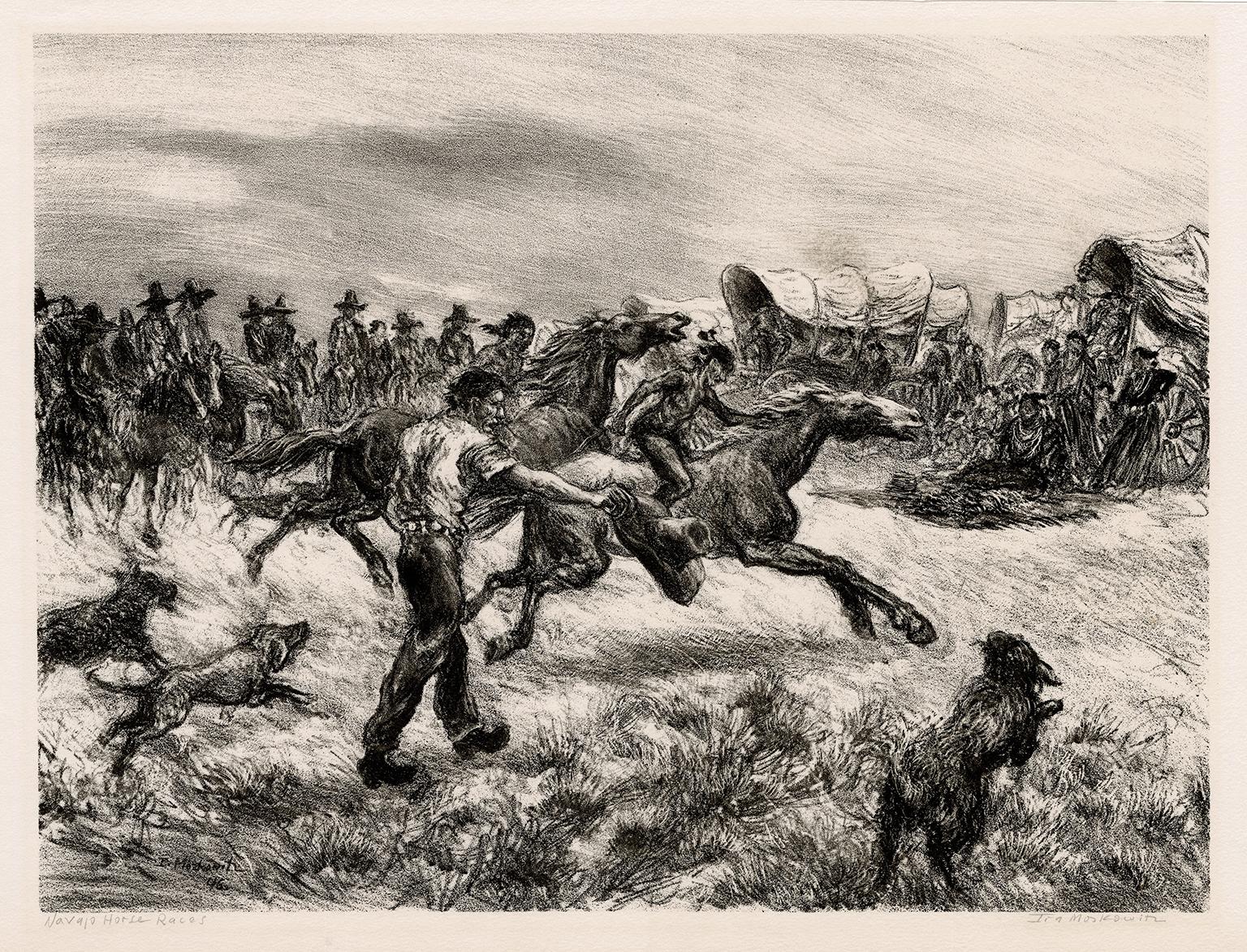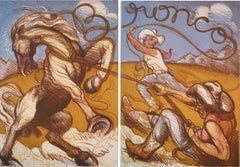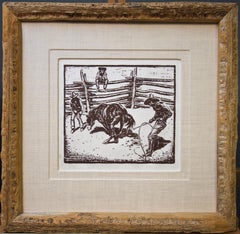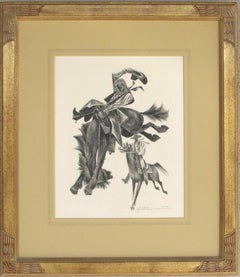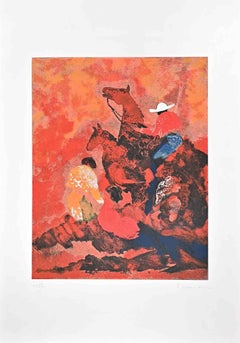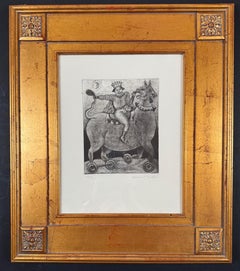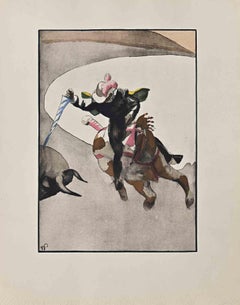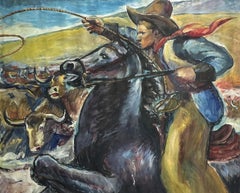Items Similar to Jo Mora, Evolution of the Cowboy 1933, from Jo Mora Estate
Want more images or videos?
Request additional images or videos from the seller
1 of 12
Joseph Jacinto MoraJo Mora, Evolution of the Cowboy 1933, from Jo Mora Estate1933
1933
$7,000
£5,316.67
€6,115.15
CA$9,780.37
A$10,906.22
CHF 5,690.40
MX$133,823.45
NOK 72,429.75
SEK 68,625.61
DKK 45,639.59
Shipping
Retrieving quote...The 1stDibs Promise:
Authenticity Guarantee,
Money-Back Guarantee,
24-Hour Cancellation
About the Item
Evolution of the Cowboy, 1933
Original Lithograph
Excellent condition, came directly from Jo Mora Jr.
Unframed!!
SHIPPING CHARGES INCLUDE SHIPPING, PACKAGING & INSURANCE
Original version was called Evolution of the Cowboy, 1933 or referred today as "Sweetheart of the Rodeo", Images from the poster were used for "Sweetheart of the Rodeo", the sixth album by American rock band the Byrds and was released on August 30, 1968. It was hated when released, today it is considered one of the great classics.
This is an original lithograph from the Jo Mora Estate from Jo Mora Jr.
Joseph Jacinto Mora (October 22, 1876 – October 10, 1947) was a Uruguayan-born American cowboy, photographer, artist, cartoonist, illustrator, painter, muralist, sculptor, and historian who wrote about his experiences in California. He has been called the "Renaissance Man of the West".
Early life
Mora was born on October 22, 1876, in Montevideo, Uruguay. His father was the Catalan sculptor, Domingo Mora, and his mother was Laura Gaillard Mora, an intellectual born in the Bordeaux region of France. His elder brother was F. Luis Mora, who would become an artist and the first Hispanic member of the National Academy of Design. The family entered the United States in 1880 and first settled in New York City, and then Perth Amboy, New Jersey.
Jo Mora 1931 Yosemite map
Jo Mora studied art at the Art Students League of New York and the Cowles Art School in Boston. He also studied with William Merritt Chase. He worked as a cartoonist for the Boston Evening Traveller, and later, the Boston Herald.
In the spring of 1903, Mora arrived in Solvang, California. He stayed at the Donohue Ranch. He made plans to travel to the Southwest to paint and photograph the Hopi. He spent time at the Mission Santa Inés; those photographs are now maintained by the Smithsonian Institution. Mora visited many Spanish missions in California that summer by horseback. He followed the "Mission Trail", also called the "Kings Highway".
In 1904, Mora visited Yosemite. Later, in 1904, to 1906, visited Arizona where he took photographs, painted and otherwise recorded the daily life of these Native Americans. Because the Hopi and other tribes have voiced their concerns more recently about photographs depicting religious ceremonies, the tribal nation should be contacted before they are used. He learned the Native languages and made detailed drawings of what he observed.
Career
In 1907, Mora wrote and illustrated the comic strip Animaldom.
In 1907, Mora returned to California and married Grace Needham. Their son, Joseph Needham Mora, was born on March 8, 1908. The Moras moved to San Jose, California, where Mora continued his work.
On 22 February 1911, the Native Sons of the Golden West Building, in San Francisco, with six terra cotta panels, by Domingo Mora and his son, Jo Mora, was dedicated.
In 1915, he served on the International Jury of Awards at the Panama–Pacific International Exposition and displayed six sculptures.[9]
In 1915-16 two of his sculptural commissions were revealed: the bronze memorial tablet with the profile of the late Archbishop Patrick W. Riordan for the Knights of Columbus and the Cervantes Monument in San Francisco's Golden Gate Park.[10][11] By 1919, he was sculpting for the Bohemian Club, including the Bret Harte Memorial plaque, completed in August 1919 and mounted on the outside of the private men's club building in San Francisco.
Carmel-by-the-Sea
In 1921, the Mora family relocated to Carmel-by-the-Sea, California, the largest art colony on the West Coast, making it their primary residence. He constructed a Craftsman-style home, which is located on the west side of San Carlos Street, the third house south of 1st Avenue.
Mora received a commission for the bronze and travertine Cenotaph, for Father Junípero Serra in the Memorial Chapel at the west end of Mission Carmel.
Mora was a director of the Carmel Art Association as early as 1934. His sculptures were exhibited between 1927 and 1934 in various galleries in Carmel.
Jo Mora is a serious sculptor, a responsible amateur actor; when mixed up with pen and ink, a humorist! Comic strips was once his trade. He was famous at it. That was years ago but his art of cartooning bloomed again when in recent years he produced the well known Mora Map of the Monterey Peninsula. Most successful with bronze statue creations which decorate many gardens in East and West. If he has a specialty in figures it is cowboys. He knows his West. Jo Mora will ever be famed for his portrayal of Pancho Lopez, The Bad Man, at Carmel Playhouse. He does everything well and is handsome while doing it. He is happily married-alas!
— Carmel Pine Cone
During the Great Depression, Mora created the "Carmel Dollar" as part of Carmel's program, offering unemployed residents scrip for public service, exchangeable for groceries and essentials; a three-cent stamp on the certificate's back acknowledged their efforts. When full, merchants accepted the certified scrip for goods or a dollar.
Architect Robert Stanton collaborated closely with Mora on multiple projects. In 1937, Stanton was the architect for the Monterey County Courthouse, which incorporated Mora's bas-relief panels, column caps, and figurative heads on both the building's exterior and its interior courtyard.
Statue of Junipero Serra in Carmel Woods.
On July 22, 1922, for the opening day of the Carmel Woods subdivision, Mora had carved and painted a wooded statue of Padre Junípero Serra, which was installed within a small wooden shrine, surrounded by plants and a pair of wooden benches at the entrance to the development, at the intersection of Camino del Monte and Alta Avenue.
In 1925, he designed the commemorative half dollar for the California Diamond Jubilee. During this period he also illustrated a number of books, made large murals, and published charts, maps (cartes) and diagrams of the West and Western themes. Beginning in 1937, Mora wrote and illustrated children's books about the West. In 1939, a Works Progress Administration project was completed, with Mora bas-relief sculpture adorning the King City High School Auditorium building.
Pebble Beach
In 1931 Jo, his wife, and daughter Patricia moved to nearby Pebble Beach into a newly built home. Five years later in the adjoining large studios he completed his massive diorama, Discovery of the San Francisco Bay by Portola, for the California Pavilion at the 1939-40 Golden Gate International Exposition on Treasure Island. At a length of almost 100 feet, with 64 sculptures of Spaniards and Indians and over 200 animals, it was said "to surpass anything of its kind at the Fair." He fashioned smaller dioramas for the Will Rogers Memorial Museum in Claremore, Oklahoma, and the Sutter's Fort Museum in Sacramento, California.
In 1928, Mora made the "El Paseo" sculpture in the courtyard of the El Paseo Building on Dolores Street and 7th Avenue in Carmel. It is a terracotta sculpture of a Californio man and a Señorita woman.
In the early 1930s, Mora was commissioned by Earl F. Graft to decorate the Carmel Dairy Building in Carmel. Mora made three large interior dairy murals above a soda fountain (no longer present) and a sculptured a metal lamp in the shape of a cowbell that still hangs above the buildings front door. He showed animal figures dressed as humans, many recognizable as local Carmel residents. He also designed the menus, Christmas cards, and milk bottles, with these animal characterizations, and a cow that served as the logo. The Santa Rosa Republican described Mora's work with an article having the title: "Carmel's Prosaic Dairy is Art."
- Creator:Joseph Jacinto Mora (1876 - 1947, American)
- Creation Year:1933
- Dimensions:Height: 31 in (78.74 cm)Width: 25 in (63.5 cm)
- Medium:
- Period:
- Condition:
- Gallery Location:Phoenix, AZ
- Reference Number:1stDibs: LU2623215162662
About the Seller
No Reviews Yet
Vetted Professional Seller
Every seller passes strict standards for authenticity and reliability
1stDibs seller since 2023
5 sales on 1stDibs
Typical response time: <1 hour
- ShippingRetrieving quote...Shipping from: Phoenix, AZ
- Return Policy
Authenticity Guarantee
In the unlikely event there’s an issue with an item’s authenticity, contact us within 1 year for a full refund. DetailsMoney-Back Guarantee
If your item is not as described, is damaged in transit, or does not arrive, contact us within 7 days for a full refund. Details24-Hour Cancellation
You have a 24-hour grace period in which to reconsider your purchase, with no questions asked.Vetted Professional Sellers
Our world-class sellers must adhere to strict standards for service and quality, maintaining the integrity of our listings.Price-Match Guarantee
If you find that a seller listed the same item for a lower price elsewhere, we’ll match it.Trusted Global Delivery
Our best-in-class carrier network provides specialized shipping options worldwide, including custom delivery.More From This Seller
View AllIndians of North America 1936 by Jo Mora
Located in Phoenix, AZ
Indians of North America 1936
Jo Mora
Lithograph
Paper size: 31 7/8 x 24 1/4 inches
Image size; 30 1/4 x 22 7/8 inches
These are the original lithographs from the Jo Mora Estate from Jo Mora Jr.
THESE ARE NOT REPRODUCTIONS!
SHIPPING CHARGES INCLUDE SHIPPING, PACKAGING & INSURANCE
Joseph Jacinto Mora 1876 – 1947
Mora was born in Montevideo, Uruguay, and was the son of Domingo Mora, a well-known painter and sculptor who brought his family to the United States in the mid 1890s and then became a teacher in New York at the Art Students League. Joseph and his artist brother Luis Mora (1874-1940) grew up being much influenced by the creative atmosphere of their father’s studio. In 1904, he returned to Arizona and New Mexico and lived with Hopi and Navajo tribes, learning their languages and painting depictions of their ceremonies, especially the Kachina ceremonial dances. One of the results of his Western travels was a series of humorous maps that were spoofs of the national parks and that were made into posters. In the 1930s, the maps sold for 25 cents each and were distributed through souvenir shops at the parks. He also painted a watercolor series, “Horsemen of the West” and wrote two books, “Trail Dust and Saddle Leather” and “Californios.” Joseph Mora died in Pebble Beach on October 10, 1947. Devoting his life to exploration of subjects as diverse as vaqueros, Hopi Kachina figures, the Arizona landscape, and California missions, Joseph Mora also excelled as a writer, photographer, designer, children’s book illustrator, and map maker.
“Apart from the bread and butter commissions that he referred to as “pot-boilers,” Mora has left a vast legacy of fine artwork. His contributions to public sculpture and architectural decorations, which are numerous and diverse, gaze calmly at the world from buildings in Los Angeles, San Francisco, Salinas, San Jose and Portland. Mora’s dioramas and large-scale figures are permanently in Monterey and Sacramento, California and Claremore and Bartlesville, Oklahoma. His drawings, paintings and photographs are cherished in private collections and private institutions across the country and first editions of his books are highly valued. But in the final analysis, Mora’s most important works may be his cartes.
In these entertaining maps, Mora combined his encyclopedic knowledge of history, his writing, drawing, and cartooning skills, his fine sense of design, and his sense of playfulness to create an art form uniquely his own. Mora’s cartes are still captivating more than fifty years after their completion, and they exemplify the popular, entertaining, direct, and informative art at which Mora excelled.”
Betty Hoag McGlynn
• Original works by Maynard Dixon, Lon Megargee, Ed Mell, Fritz Scholder, Bill Schenck, Bill Lesch, Luis Jimenez, Greg
Singley, Dan Budnik, and other 20th century Western, WPA and Contemporary Southwestern artists.
• The Fine Art Estate of Lon Megargee
• Vintage rodeo...
Category
1930s Other Art Style More Prints
Materials
Lithograph
Bronco
Located in Phoenix, AZ
SHIPPING FEES INCLUDE SHIPPING CHARGE, PACKAGING & **INSURANCE**
Luis Alfonso Jimenez
Born, 1940, El Paso, Texas, died 2006, Hondo, New Mexico.
Statement: Luis Jimenez, in his work, celebrates the vitality of life. . . . Jimenez es un hijo de la frontera; he knows its people and the landscape. It is the transformation of these people into art that is his most important contribution to the art of this vast region which stretches between Mexico and the United States.
His subject matter utilizes the popular images of the cultura del norte, and a large part of it is depicted and transformed in the rough and tumble world of la frontera. He is also a son of el norte, and so he uses its materials and explores its emerging, popular myths. The tension and attraction of Jimnez’s work is that he always creates within the space of his two worlds, the Mexicano and the Americano. He constantly shows us the irony of the two forces which repel, while showing us glimpses of the synthesis he seeks. What a gift it has been to us for this talented artist to reflect on the soul of our region. He gives meaning to our existence and history.
Rudolfo Anaya (passage chosen by the artist), A View from La Frontera, Man on Fire: Luis Jimnez, pp. 1, 3, 6Biography: Luis Jimnez was born in Texas to parents who had emigrated from Mexico to the United States; he would later dedicate his 1989 sculpture Border Crossing to his father, who had entered the country illegally. The elder Jimnez was a neon sign designer in El Paso, and Luis worked with him as a youth. His experience working in the neon shop and his fascination with U.S. car culture would both become major influences on his art career.
Jimenez studied architecture at the University of Texas, Austin (UTA), and also took art courses in which he first created sculptures with wood, steel, and fiberglass, choosing the latter because of its association with U.S. popular culture. He subsequently became one of the artists who made fiberglass an acceptable medium in the 1960s. In 1964 Jimenez received his B.S. in art from UTA, and he continued his studies at the Universidad Nacional Autnoma de Mexico in Mexico City.
In 1966 he moved to New York City and worked as an assistant to sculptor Seymour Lipton. Jimnez began to exhibit his art while in New York and in 1972 moved to New Mexico to focus on creating public sculptures, even as he maintained his diverse output of drawings, prints, and lithographs.
Drawing on his early experiences, Jimnez creates works that come from a border perspective, one that draws upon the hybridity bred by culture clashes. Often socially and politically informed, his works speak not only in regional terms, those germane to the southwestern United States, but to broader, more global issues as well. They exhibit a profoundly Chicano aesthetic and sensibility, one that is informed by Mexican and Mexican American traditions, North American popular culture, Chicano cultural icons, and images and themes unique to the Southwest. Death, sexuality, and the struggle of the common people are frequent themes.
Inspired by authors who write in an autobiographical style, Jimnez creates works that function as personal narrative yet are also able to make statements about culture in more global terms. His use of bold colors and lines, a legacy from his fathers work as a neon sign maker, lends a dynamic sensuality to his work, one that is particularly evident in his monumental fiberglass and acrylic urethane sculptural works
Many of Jimnezs works correspond to scholar Toms Ybarra-Fraustos definition of the Chicano aesthetic of rasquachismo, a lowbrow sensibility that appeals to the working class in that it applies to objects that subvert expressions of the mainstream or dominant culture. Creating art that speaks to the people, Jimnez is able to transform regional and culturally specific myths and symbols into globally recognized and relevant icons.
Exhibitions:
In addition to his personal work, Jimnez has been commissioned for numerous public art projects. In 1999 his sculpture Southwest Piet was designated a National Treasure by First Lady Hillary Clinton.
The many exhibitions featuring his work have included Human Concern/Personal Torment (Whitney Museum of American Art, New York, 1969).
The First International Motorcycle Art Show (Phoenix Art Museum, Phoenix, AZ, 1973).
Three Texas Artists (Centre Cultural Americaine, USIS, Paris, 1977),
Recent Trends in Collecting (Smithsonian Institution, Washington, DC, 1982).
Committed to Print (Museum of Modern Art, New York, 1989)
Printmaking in Texas: The 1980s (Modern Art Museum, Fort Worth, TX.
Laguna Gloria Art Museum, Austin, 1990.
The Whitney Biennial (Whitney Museum of American Art, New York, 1991)
Man On Fire: Luis Jimnez (Albuquerque Museum of Art, NM, 1994-95).
47th Annual Purchase Exhibition (American Academy of Arts and Letters, New York, 1995).
Traveling solo exhibition, Working Class Heroes: Images from the Popular Culture (1997-2000).
Jiménez
Collier Gallery has been in continuous operation for over 40 years. Originally located just off Main Street in downtown Scottsdale, Arizona, we have moved to Phoenix to accommodate and showcase our large inventory including:
• Original works by Maynard Dixon, Lon Megargee, Ed Mell, Fritz Scholder, Bill Schenck, Bill Lesch, Luis Jimenez, Greg
Singley, Dan Budnik, and other 20th century Western, WPA and Contemporary Southwestern artists.
• The Fine Art Estate of Lon Megargee
• Vintage rodeo...
Category
1970s Contemporary Figurative Prints
Materials
Lithograph
Bronc by Lon Megargee, Woodblock Print ca. 1920s with Handmade Saguaro Rib Frame
Located in Phoenix, AZ
SHIPPING CHARGES INCLUDE SHIPPING, PACKAGING & **INSURANCE**
Bronc by Lon Megargee, Woodblock Print ca. 1920s
Handmade Saguaro Rib Frame, double linen mat, museum archival materials
Bronc
Woodblock Print, signed in print
Image: 8 3/4 x 9 7/8 inches
Frame: 21 x 20 inches
SHIPPING CHARGES INCLUDES, SHIPPING, PACKAGING & INSURANCE
FINE ART ESTATE OF LON MEGARGEE
Megargee Custom Handmade Saguaro Frame
We offer signed in print and original signature block prints. Custom, hand carved, signature frames, with archival standards and a speciality in hand dyed mats and french matting are provided for a beautiful and timeless presentation.
Free shipping Continental US
Biography
Megargee explored different mediums; printmaking captivated him in particular. The contrast of the black and white block print method captured perfectly his interpretation of a bold American West. The first print was produced around 1921 and culminated with the creation of “The Cowboy Builds a Loop” in 1933 with 28 images and poetry by his friend, Roy George. Megargee continued producing prints throughout the 1940s and early 50s.
Creator of the iconic logo for the Stetson Hat Company, " Last Drop From his Stetson", still in use today.
Fine Art Estate of Lon Megargee
At age 13, Lon Megargee came to Phoenix in 1896 following the death of his father in Philadelphia. For several years he resided with relatives while working at an uncle’s dairy farm and at odd jobs. He returned to Philadelphia in 1898 – 1899 in order to attend drawing classes at the Pennsylvania Academy of the Fine Arts. Back in Phoenix in 1899, he decided at the age of 16 to try to make his living as a cowboy. Lon moved to the cow country of Wickenburg where he was hired by Tex Singleton’s Bull Ranch. He later joined the Three Bar Ranch . . . and, after a few years, was offered a job by Billy Cook...
Category
Early 20th Century Figurative Prints
Materials
Woodcut
High Wide and Handsome by Fletcher Martin 1953, Original Stone Lithograph
By Fletcher Martin
Located in Phoenix, AZ
SHIPPING CHARGES INCLUDE SHIPPING, PACKAGING & **INSURANCE**
Fletcher Martin
Size: 16 x12 inches
Stone lithograph
Frame 25 x 21 inches
High, Wide and Handsome- - 1953, Lithograph....
Category
1950s Contemporary Figurative Prints
Materials
Lithograph
Jo Mora's 1928 "Carte" of San Diego, Very Rare Pictorial Map
Located in Phoenix, AZ
Jo Mora's 1928 "Carte" of San Diego, Very Rare Pictorial Map
Size: 28 x 22.5 in (71.12 x 57.15 cm)
Every good condition for it's age
Originally came folded in envelope for mailing....
Category
1920s Other Art Style More Prints
Materials
Lithograph
Siesta by Lon Megargee 1929, Archival Pigmrnt Print
Located in Phoenix, AZ
Tequila Siesta
Lon Megargee
Archival Pigment Print
100% 300 gram cotton rag paper
Size: 22.5 x 27 inches
Paper size: 24 x 28.5 inches
Creator of the iconic logo for the Stetson Hat Company, " Last Drop From his Stetson", still in use today.
Fine Art Estate of Lon Megargee
At age 13, Lon Megargee came to Phoenix in 1896 following the death of his father in Philadelphia. For several years he resided with relatives while working at an uncle’s dairy farm and at odd jobs. He returned to Philadelphia in 1898 – 1899 in order to attend drawing classes at the Pennsylvania Academy of the Fine Arts. Back in Phoenix in 1899, he decided at the age of 16 to try to make his living as a cowboy. Lon moved to the cow country of Wickenburg where he was hired by Tex Singleton’s Bull Ranch. He later joined the Three Bar Ranch . . . and, after a few years, was offered a job by Billy Cook...
Category
1920s Figurative Prints
Materials
Archival Pigment
You May Also Like
Bullfight - Lithograph by José Guevara - 20th Century
Located in Roma, IT
Bullfight is an artwork realized by Josè Guevara in the 20th century.
Colored lithograph on paper. Edited by Fondazione Di Paolo.
Hand-signed in penci...
Category
Late 20th Century Contemporary Figurative Prints
Materials
Lithograph
untitled (horseman)
By Maximino Javier
Located in Palm Springs, CA
This whimsical and surreal etching by Mexican artist Maximino Javier, dated 1984, embodies his unique visual language that blends fantasy, folklore, and satire. Executed with intrica...
Category
1980s Contemporary Figurative Prints
Materials
Etching
The Great Picador - Drawing by Hermann Paul - Early 20th Century
Located in Roma, IT
The Great Picador is a Gouache on Paper realized by Hermann Paul.
Monogrammed on the lower left corner.
Good condition.
René Georges Hermann-Paul (27 December 1864 – 23 June 1940)...
Category
Early 20th Century Modern Figurative Drawings and Watercolors
Materials
Paper, Gouache
Cowboys Horses Cattle WPA American Scene Social Realism Mid 20th Century Modern
By Jo Cain
Located in New York, NY
Cowboys Horses Cattle WPA American Scene Social Realism Mid 20th Century Modern
Jo Cain (1904 – 2003)
Cowboy
33 3/4 x 36 inches
Oil on paper, c. 1930s
Signed...
Category
1930s American Realist Figurative Drawings and Watercolors
Materials
Paper, Oil
'Navajo Horse Race' — Southwest Regionalism, American Indian
By Ira Moskowitz
Located in Myrtle Beach, SC
Ira Moskowitz, 'Navajo Horse Race', lithograph, 1946, edition 30, Czestochowski 204. Signed and titled in pencil. Signed and dated in the stone, lower le...
Category
1940s American Modern Landscape Prints
Materials
Lithograph
El Vaquero, by Xavier Viramontes
By Xavier Viramontes
Located in Palm Springs, CA
This is one of six cowboy images completed by the artist. Chicano artist Viramontes is known for both political subject matter, as well as more personal s...
Category
21st Century and Contemporary Contemporary Figurative Prints
Materials
Etching, Aquatint
$720 Sale Price
20% Off
More Ways To Browse
Cowboys And Indians
Renaissance Art Pairings
Art Gallery Benches
Fountain Woman
Vintage Shriners
Cow Head
Small Indian Sculptures
Cow Mount
Vintage Indian Dress Dresses
Vintage Treasure Island
Chapel Door
Wood Diorama
Bronze Sculpture Cap
Treasure Map
Indian Painted Door
Childrens Bench
Metal French Gate
Sculpture Terracotta Man
